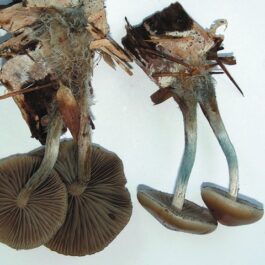When foraging for Psilocybe cyanescens, also known as the “wavy cap” mushroom, it’s essential to be mindful of potential look-alike species to ensure safety.
Here are some mushrooms that may resemble Psilocybe cyanescens:
Galerina marginata: This mushroom, commonly known as the “deadly galerina,” bears a resemblance to Psilocybe cyanescens, especially in its young stage.
However, Galerina marginata is highly toxic and should never be consumed.
Hypholoma species: Certain mushrooms from the Hypholoma genus, such as Hypholoma fasciculare, share visual similarities with Psilocybe cyanescens.
These mushrooms can be mistaken for P. cyanescens, but they do not contain psychoactive compounds.
Conocybe filaris: This mushroom, often referred to as the “death cap,” may share some visual characteristics with Psilocybe cyanescens, particularly in terms of coloration and cap shape.
Conocybe filaris is extremely toxic and should be avoided at all costs.
Given the potential risks associated with wild mushroom foraging, it is crucial to exercise extreme caution and prioritize safety.
Without expert knowledge and comprehensive understanding of mycology, individuals should refrain from consuming wild mushrooms.
Seeking guidance from experienced mycologists or mycological societies can provide valuable insights into safe foraging practices and mushroom identification.
Always err on the side of caution when dealing with wild mushrooms.

